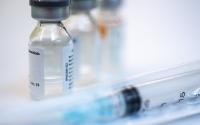[ad_1]
COVID-19 infection was very low in a cohort of vaccinated California healthcare workers (HCWs) amid a surge of new cases, according to a research letter yesterday in the New England Journal of Medicine.
University of California researchers evaluated COVID-19 infection rates in 36,659 HCWs on the San Diego and Los Angeles campuses vaccinated with at least one dose of the Moderna or Pfizer/BioNTech vaccine from Dec 16, 2020, to Feb 9, 2021. In that timeframe, 28,184 (77%) received the second dose of vaccine.
Of the 36,659 vaccinated HCWs, 379 (1.0%) tested positive for COVID-19 1 or more days after vaccination, 71% of them within the first 2 weeks after the first dose. Of the 28,184 HCWs who received their second dose, 37 (0.1%) tested positive, 22 of them 1 to 7 days later. Eight tested positive 8 to 14 days later, and 7 did so at least 15 days later.
With 5,455 HCWs at the San Diego campus and 9,535 at the Los Angeles campus who received their second vaccine dose at least 2 weeks before testing, the findings correspond to a 0.05% positivity rate. The absolute risk of infection after vaccination was 1.19% among San Diego HCWs and 0.97% among those in Los Angeles.
“We were able to describe the infection rates in a real-world scenario, where vaccine roll-out coincided with a surge of infections,” coauthor Jocelyn Keehner, MD, of the University of California San Diego (UCSD), said in a UCSD news release. “We observed a low overall positivity rate among fully immunized health care workers, supporting the high protection rates of these vaccines.”
Table of Contents
Comparing HCWs and vaccine trial participants
The authors noted that the rates of infection in their study were higher than those reported in phase 3 clinical trials of the Moderna and Pfizer vaccines, perhaps because of the availability of regular testing of asymptomatic and symptomatic HCWs at their health systems, a surge of COVID-19 cases in Southern California at the time of their vaccination drives, and demographic differences between the vaccine trial participants and the HCWs in the study cohort.
Asymptomatic HCWs at the San Diego campus underwent mandatory weekly COVID-19 testing starting Dec 2, 2020, and their Los Angeles counterparts were offered testing beginning Dec 26.
The HCWs were younger than the vaccine trial participants and at higher risk of exposure to coronavirus due to their occupations. The vaccine trial reporting cutoff dates were also well before the Southern California surge, no testing of asymptomatic participants was done in the Pfizer vaccine trial, and the Moderna trial tested asymptomatic participants only once before administering the second dose, the authors said.
Risk is not zero
The researchers said that the low rate of COVID-19 infection in their study 14 days after administration of the second vaccine dose is a hopeful sign and suggests that the vaccines remain effective outside of clinical trials.
However, the vaccines are not 100% effective, they said, pointing out vaccine trial efficacies of 94.1% against severe COVID-19 14 days after the second dose for the Moderna vaccine and 95% 7 days after the second dose for the Pfizer version.
Also, the authors added, since the publication of the trial data in November 2020, events that could have changed the clinical picture have occurred, including a nationwide COVID-19 surge, the emergence and proliferation of new coronavirus variants, and vaccines rollouts across the country under emergency use authorizations from the US Food and Drug Administration.
“These data underscore the critical importance of continued public health mitigation measures (masking, physical distancing, daily symptom screening, and regular testing), even in environments with a high incidence of vaccination, until herd immunity is reached at large,” they wrote.
[ad_2]
Source link












